WATCH SIZE AND COMPONENTS GUIDE
Please enjoy our comprehensive guide to watch sizing, care, handling, watch functions and parts, to ensure your future watch purchases, and pending watch care comes from an informed place. From casing to plating, movement to waterproofing, we have covered every aspect of the anatomy of a watch to assist you in the buying, and care processes.
WATCH SIZE AND COMPONENTS GUIDE
Please enjoy our comprehensive guide to watch sizing, care, handling, watch functions and parts, to ensure your future watch purchases, and pending watch care comes from an informed place. From casing to plating, movement to waterproofing, we have covered every aspect of the anatomy of a watch to assist you in the buying, and care processes.
WATCH SIZE GUIDE - HOW TO FIND THE PERFECT WATCH FOR YOUR WRIST
WATCH CASE SIZE
Watches are available in a large variety of sizes and the size of a watch can make a big difference to its overall look and feel. Now that more and more people are buying online, its important to know your wrist size so that you can find the
correct watch for your needs.
Here are some things to keep in mind when buying a watch, in-store or online:
• The watch case is the part of the watch that houses the dial, battery, movement and other working parts.
• The watch case diameter is the most significant and noticeable element when it comes to selecting the right watch.
• Men’s watches usually range between 38mm and 46mm, although if you’re looking at a vintage timepiece 34mm to 36mm were common sizes for
men and are still a classic size today.
• To measure the size of the watch case, measure the diameter at the widest point of the watch (perpendicular to the watch lugs),
not including the crown.
How to choose the right watch for your needs:
Here are some key questions that one should ask when choosing a watch:
• Does the look match the lifestyle of the wearer?
• Does the water resistance meet the intended use?
• How good is the quality of the glass?
• What type of movement is used?
• Are the dial features appealing and functional?
• Luminous markings on the dial are an advantage at night. Is this important to you?
• Length of guarantee. This indicates confidence in the product by the manufacturer.
• Quality and thickness of the plating. The thicker the plating, the longer it lasts.
• What is the underlying material of the case and strap? Stainless steel for example is superior to alloy or brass.
• Special functions needed - does the watch cater for your personal technical requirements?
Watch sizes are generally broken down like this:
34mm: Small
34mm – 38mm: Midsize
39mm – 42mm: Standard
43mm +: Extra Large/Oversize
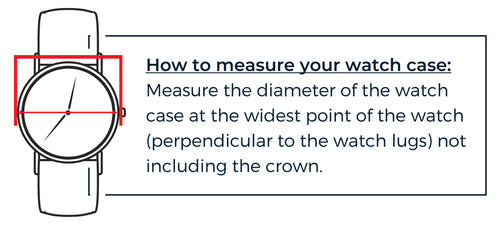
WATCH SIZE GUIDE - HOW TO FIND THE PERFECT WATCH FOR YOUR WRIST
WATCH CASE SIZE
Watches are available in a large variety of sizes and the size of a watch can make a big difference to its overall look and feel. Now that more and more people are buying online, its important to know your wrist size so that you can find the
correct watch for your needs.
Here are some things to keep in mind when buying a watch, in-store or online:
• The watch case is the part of the watch that houses the dial, battery, movement and other working parts.
• The watch case diameter is the most significant and noticeable element when it comes to selecting the right watch.
• Men’s watches usually range between 38mm and 46mm, although if you’re looking at a vintage timepiece 34mm to 36mm were common sizes for
men and are still a classic size today.
• To measure the size of the watch case, measure the diameter at the widest point of the watch (perpendicular to the watch lugs),
not including the crown.
How to choose the right watch for your needs:
Here are some key questions that one should ask when choosing a watch:
• Does the look match the lifestyle of the wearer?
• Does the water resistance meet the intended use?
• How good is the quality of the glass?
• What type of movement is used?
• Are the dial features appealing and functional?
• Luminous markings on the dial are an advantage at night. Is this important to you?
• Length of guarantee. This indicates confidence in the product by the manufacturer.
• Quality and thickness of the plating. The thicker the plating, the longer it lasts.
• What is the underlying material of the case and strap? Stainless steel for example is superior to alloy or brass.
• Special functions needed - does the watch cater for your personal technical requirements?
Watch sizes are generally broken down like this:
34mm: Small
34mm – 38mm: Midsize
39mm – 42mm: Standard
43mm +: Extra Large/Oversize


LUGS
Watch lugs are the metal extensions where the bracelet or strap attaches to the watch case. Lugs are not included in case size measurements. So when measuring your wrist for case diameter size, leave some room for the lugs. A good indication of whether a watch is too big is to look at the lugs. If they extend past the curve of your wrist, then the watch does not fit right and could be uncomfortable to wear.
CASE THICKNESS
Now that watches are becoming larger and the case diameter increases so too does the case thickness. Many watches can be too bulky, heavy and thick so you want to consider the thickness of the case when deciding on a watch. Watch thickness is important for practical purposes as well. Factor in the clothes that you would most typically wear with your watch and decide if a bigger watch will look good.

WATCH STRAPS AND BRACELETS
Sizing a watch to fit appropriately isn’t much of a concern unless you have a very large wrist. Most women’s watches are between 172mm - 178mm in length and most men’s watches are 191mm - 204mm in length. The length of the strap is based on wrist circumference and can be divided in two – the tail (long) end and the buckle (short) end. That’s why the strap length is sometimes presented as 120/70mm. The first number (120) is the length of the long end in millimeters while the second number (70) is the buckle end in millimeters. When deciding on strap length, measure your wrist and subtract the watch case size from the wrist length to get your watch strap length.
*The case size length measurement does not include the lugs
*The buckle side length measurement does not include the buckle

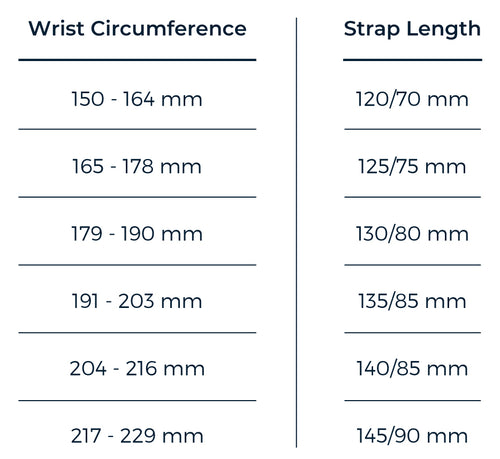
Leather, nylon, or any other non-metal strap can be adjusted for length when you wear the watch by cinching to the most comfortable pre-made hole. Metal bracelets can be adjusted for length by removing or adding links. You can take your watch into one of our stores to do this. The strap width of your watch is determined by the distance between the lugs of your watch case. Watches with smaller strap widths are typically good for those with slender wrists and for women. People with larger wrists are better suited to wear watches with wider straps.

LUGS
Watch lugs are the metal extensions where the bracelet or strap attaches to the watch case. Lugs are not included in case size measurements. So when measuring your wrist for case diameter size, leave some room for the lugs. A good indication of whether a watch is too big is to look at the lugs. If they extend past the curve of your wrist, then the watch does not fit right and could be uncomfortable to wear.
CASE THICKNESS
Now that watches are becoming larger and the case diameter increases so too does the case thickness. Many watches can be too bulky, heavy and thick so you want to consider the thickness of the case when deciding on a watch. Watch thickness is important for practical purposes as well. Factor in the clothes that you would most typically wear with your watch and decide if a bigger watch will look good.

WATCH STRAPS AND BRACELETS
Sizing a watch to fit appropriately isn’t much of a concern unless you have a very large wrist. Most women’s watches are between 172mm - 178mm in length and most men’s watches are 191mm - 204mm in length. The length of the strap is based on wrist circumference and can be divided in two – the tail (long) end and the buckle (short) end. That’s why the strap length is sometimes presented as 120/70mm. The first number (120) is the length of the long end in millimeters while the second number (70) is the buckle end in millimeters. When deciding on strap length, measure your wrist and subtract the watch case size from the wrist length to get your watch strap length.
*The case size length measurement does not include the lugs
*The buckle side length measurement does not include the buckle

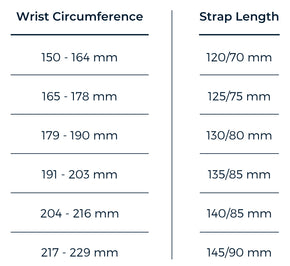
Leather, nylon, or any other non-metal strap can be adjusted for length when you wear the watch by cinching to the most comfortable pre-made hole. Metal bracelets can be adjusted for length by removing or adding links. You can take your watch into one of our stores to do this. The strap width of your watch is determined by the distance between the lugs of your watch case. Watches with smaller strap widths are typically good for those with slender wrists and for women.
People with larger wrists are better suited to wear watches with wider straps.
WATCH COMPONENTS GUIDE
The proportions of a watch come down to its unique lug size, pusher and crown size and many other visible parts. Larger hand sizes and numbers can make a watch appear larger. These elements all play a part in the overall aesthetic and balance of the watch, and should complement each other.
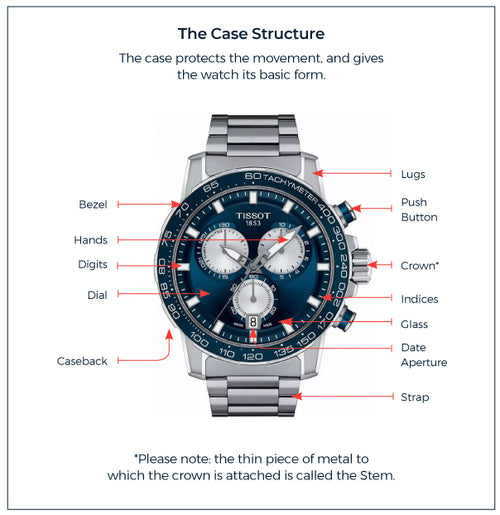

WATCH COMPONENTS GUIDE
The proportions of a watch come down to its unique lug size, pusher and crown size and many other visible parts. Larger hand sizes and numbers can make a watch appear larger. These elements all play a part in the overall aesthetic and balance of the watch, and should complement each other.
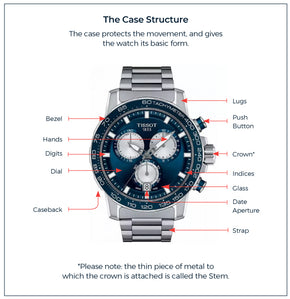
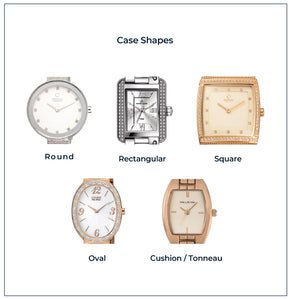
CASEBACK
The caseback is the plate at the back of the watch, which secures the watch movement in place. Casebacks often reveal brandings and important details about the watch.
CROWN
Screw down crowns and push down crowns seal watches up to 300m, for water proofing purposes.
It is very important when removing and closing a caseback, to check that the rubber gasket is correctly sealed to ensure adequate waterproofing.
DIALS
The dial presents the face of the watch. The dial design will vary according to the functionality of the watch.

CASE AND BRACELET MATERIALS
The following table explains the advantages of different materials:

GLASS:
The glass protects the dial and the hands:
• Plastic offers many options for transparent / opaque designs and colourways
• Mineral glass is very durable, is affordable and more scratch resistant than acrylic or plastic.
• Sapphire is extremely scratch resistant – sapphire belongs to the corundum family and boasts a hardness of 9, directly below diamond, which is the hardest material known to man. It is the material best known to protect the watch dial against shock.
BANDS AND STRAPS
Bands and straps can be made from many different materials and are fastened by a buckle:
Resin, Gold, Alloy, Plastic, Platinum, Stainless Steel, Rubber,
Brass, Leather, Mesh, Titanium
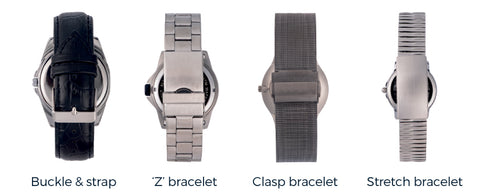
BEZELS
The Bezel is the outer ring which surrounds the glass, emphasizing its shape. Moving bezels are usually found in sports models and are designed as a flexible timer.
• One-way moving bezels move only in a clockwise direction and are typically found in divers watches. Divers typically use this as a timer.
• Two-way moving bezels move in both a clockwise and anti-clockwise direction. These are typically used in Pilot watches for fuel and
distance calculations.
• Non-moving bezels are decorative only.

CASEBACK
The caseback is the plate at the back of the watch, which secures the watch movement in place. Casebacks often reveal brandings and important details about the watch.
CROWN
Screw down crowns and push down crowns seal watches up to 300m, for water proofing purposes.
It is very important when removing and closing a caseback, to check that the rubber gasket is correctly sealed to ensure adequate waterproofing.
DIALS
The dial presents the face of the watch. The dial design will vary according to the functionality of the watch.

CASE AND BRACELET MATERIALS
The following table explains the advantages of different materials:

GLASS:
The glass protects the dial and the hands:
• Plastic offers many options for transparent / opaque designs and colourways
• Mineral glass is very durable, is affordable and more scratch resistant than acrylic or plastic.
• Sapphire is extremely scratch resistant – sapphire belongs to the corundum family and boasts a hardness of 9, directly below diamond, which is the hardest material known to man. It is the material best known to protect the watch dial against shock.
BANDS AND STRAPS
Bands and straps can be made from many different materials and are fastened by a buckle:
Resin, Gold, Alloy, Plastic, Platinum, Stainless Steel, Rubber,
Brass, Leather, Mesh, Titanium

BEZELS
The Bezel is the outer ring which surrounds the glass, emphasizing its shape. Moving bezels are usually found in sports models and are designed as a flexible timer.
• One-way moving bezels move only in a clockwise direction and are typically found in divers watches. Divers typically use this as a timer.
• Two-way moving bezels move in both a clockwise and anti-clockwise direction. These are typically used in Pilot watches for fuel and
distance calculations.
• Non-moving bezels are decorative only.
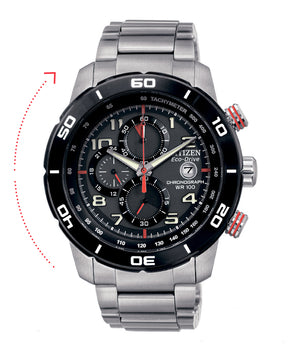
WATCH FUNCTIONS
Types of Watch Functions and features:
• ANALOGUE:
Simple Analogue has a dial with an hour hand, a minute hand, and sometimes a second hand or, Analogue day date, includes a window that shows the day, typically at 3 or 6 o’clock position.
• CHRONOGRAPH:
known commonly as a stop - watch function, is controlled by a pusher on the side of the watch.
• MULTI-FUNCTION:
features alarm and chronograph functions.
• PERPETUAL:
features a calendar function which automatically adjusts to the proper dates up to the year 2100, inclusive of leap years.
MOVEMENTS
The movement is the engine which drives the watch.
1. Mechanical Movements
Movement is typically generated by a winding function which can be wound by hand. The mechanical movement is the oldest type of movement in the horology world, and uses a coiled mainspring to release energy, which is pushed through a series of gears while it uncoils. An oscillating wheel called a balance wheel is linked to an escapement. The gear train moves the hands along to record time.
2. Quartz Movements
The most common type of movement: a miniature electric motor powered by a replaceable battery cell. Quartz is derived from silicon oxide, also known as rock crystal.
3. Automatic Movements
Power is generated by the natural movements of one’s wrist. A rotor, or oscillating semi-circular weight, is propelled into movement by the wearers movement. This winds the mainspring.
4. Kinetic Movements
This movement works on the same principle as an automatic movement, but for the fact that movement energises and stores power
in a permanent battery.
5. Digital Movements
Display of time is given in figures by electronically operated short lines, known as digits, within a translucent dial made up of liquid crystals.
6. Spring Drive
The incredibly swift and smooth movement of a spring drive is attributed to the combination of the precision of a quartz movement and the high torque value of a mechanical timepiece. Through this incredibly speedy rotation, an electrical current and magnetic brake work together, transferring an electromagnetic current to the gear train. The result is precision and a gliding movement, as opposed to the “step” of a conventional hand movement.
Spring drive is Japanese movement technology.
Commonly described attributes of a movement:
Calibre - this term indicates the shape of the movement, its origin, factory and designers name.
Shock resistance - where a watch movement is protected by a shock absorber.

WATER RESISTANCE
A common misconception is that the suggested metres indicated on the watch allow for water resistance at those levels but actually refers to bars of pressure that the watch can withstand.
The following table recommends preferred usage:
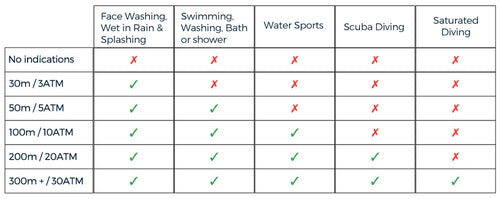
To ensure maximum water resistance, always ensure that the crown is in its proper position and that it’s not exposed to steam.
Consistently exposing a watch to steam means that the protective urethane ‘O’ rings and gaskets that maintain a watch’s water resistance regularly contract and expand and ultimately perish, marking the band as compromised, and susceptible to damage.
WATCH CARE
• Watches contain precise electronic components. Never attempt to open the case or remove the back cover.
• Do not operate push buttons below the surface of the water when swimming or diving.
• Should water or condensation appear in the watch, immediately consult your nearest dealer.
• Avoid rough usage or dropping your watch onto hard surfaces.
• Avoid exposing the watch to temperature extremes.
• Clean your watch with a soft cloth and clean water only. Avoid using chemicals, especially soap.
• Keep your watch away from strong electric fields and static electricity.
• PolyWatch glass and plastic polish kits - enable the user to polish away scratches and imperfections with ease at home
WATCH FUNCTIONS
Types of Watch Functions and features:
• ANALOGUE:
Simple Analogue has a dial with an hour hand, a minute hand, and sometimes a second hand or, Analogue day date, includes a window that shows the day, typically at 3 or 6 o’clock position.
• CHRONOGRAPH:
known commonly as a stop - watch function, is controlled by a pusher on the side of the watch.
• MULTI-FUNCTION:
features alarm and chronograph functions.
• PERPETUAL:
features a calendar function which automatically adjusts to the proper dates up to the year 2100, inclusive of leap years.
MOVEMENTS
The movement is the engine which drives the watch.
1. Mechanical Movements
Movement is typically generated by a winding function which can be wound by hand. The mechanical movement is the oldest type of movement in the horology world, and uses a coiled mainspring to release energy, which is pushed through a series of gears while it uncoils. An oscillating wheel called a balance wheel is linked to an escapement. The gear train moves the hands along to record time.
2. Quartz Movements
The most common type of movement: a miniature electric motor powered by a replaceable battery cell. Quartz is derived from silicon oxide, also known as rock crystal.
3. Automatic Movements
Power is generated by the natural movements of one’s wrist. A rotor, or oscillating semi-circular weight, is propelled into movement by the wearers movement. This winds the mainspring.
4. Kinetic Movements
This movement works on the same principle as an automatic movement, but for the fact that movement energises and stores power
in a permanent battery.
5. Digital Movements
Display of time is given in figures by electronically operated short lines, known as digits, within a translucent dial made up of liquid crystals.
6. Spring Drive
The incredibly swift and smooth movement of a spring drive is attributed to the combination of the precision of a quartz movement and the high torque value of a mechanical timepiece. Through this incredibly speedy rotation, an electrical current and magnetic brake work together, transferring an electromagnetic current to the gear train. The result is precision and a gliding movement, as opposed to the “step” of a conventional hand movement.
Spring drive is Japanese movement technology.
Commonly described attributes of a movement:
Calibre - this term indicates the shape of the movement, its origin, factory and designers name.
Shock resistance - where a watch movement is protected by a shock absorber.

WATER RESISTANCE
A common misconception is that the suggested metres indicated on the watch allow for water resistance at those levels but actually refers to bars of pressure that the watch can withstand.
The following table recommends preferred usage:

To ensure maximum water resistance, always ensure that the crown is in its proper position and that it’s not exposed to steam.
Consistently exposing a watch to steam means that the protective urethane ‘O’ rings and gaskets that maintain a watch’s water resistance regularly contract and expand and ultimately perish, marking the band as compromised, and susceptible to damage.
WATCH CARE
• Watches contain precise electronic components. Never attempt to open the case or remove the back cover.
• Do not operate push buttons below the surface of the water when swimming or diving.
• Should water or condensation appear in the watch, immediately consult your nearest dealer.
• Avoid rough usage or dropping your watch onto hard surfaces.
• Avoid exposing the watch to temperature extremes.
• Clean your watch with a soft cloth and clean water only. Avoid using chemicals, especially soap.
• Keep your watch away from strong electric fields and static electricity.
• PolyWatch glass and plastic polish kits - enable the user to polish away scratches and imperfections with ease at home

